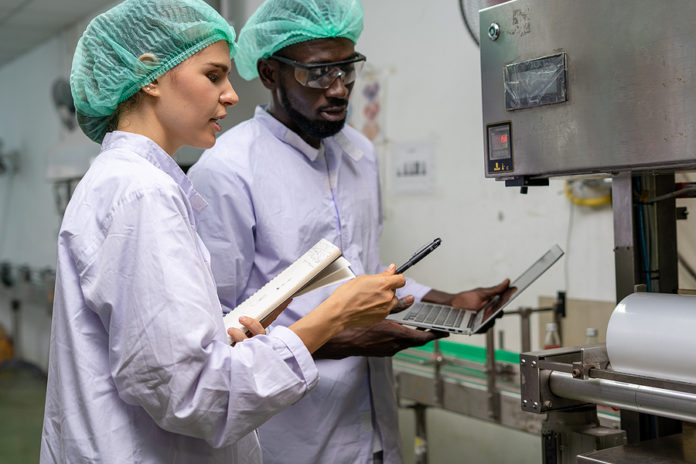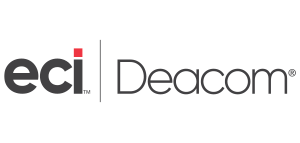
Article sponsored by Deacom ERP, an ECI Software Solution
The labor shortage in the food and beverage industry didn’t start with the pandemic (though increased demand for groceries certainly exacerbated it). The need for workers – from processing and packaging machine operators, to plant supervisors and managers, to data scientists – has been building for well over a decade. And it won’t end when the lingering impacts of the pandemic finally subside – the population continues to grow, and as we’re fond of saying in the business, “people will always need to eat.”
A good deal of time, energy, and money has been dedicated to figuring out what companies can do to attract and retain the workforce they need to meet the demands of the market. And the answer is that there’s not an easy answer. There’s no silver bullet that will make the problem go away – especially with the unemployment rate sitting at 3.7%.
But there are several ways companies can both close their existing talent gaps and put themselves into a better position for the future. The ones that succeed will be those that take a “yes, and” approach, combining short-, medium-, and long-term initiatives into what will eventually become a complete revamp of the way they source and retain talent.
The root of the problem: Perception
Manufacturing has a bad image among today’s workers. This has been the case for a while – younger people simply don’t see manufacturing as a viable career in the same way that their parents and grandparents did.
Here are just a few of the findings that reinforce this point:
- In 2009, 52% of teenagers had little or no interest in manufacturing, and the top reason was that they didn’t consider it a professional career. (Note: Those teenagers are in their late 20s or early 30s now, making them the ideal candidates to fill currently open manufacturing jobs.)
- Only about 27% of parents think manufacturing would be a good job for their kid.
- 58% of consumers feel manufacturing jobs have limited career prospects.
When you dig into the results of these and similar surveys, what you find is that people’s ideas about manufacturing don’t match the realities of today. Modern manufacturing is high-tech, involving automation, robotics, and other digital technologies. It also pays well – in Food Processing’s 2021 Salary and Job Satisfaction Survey, the average salary was almost $108,000.
But younger workers don’t know this – they still see manufacturing as a boring, repetitive job rather than an exciting, fulfilling career. (See this excellent article written by a high schooler on “Why Manufacturing’s Not Cool.”)
Deloitte has done a lot of research on what they call the “age-old perception challenge,” and they’ve identified three areas contributing to misperceptions about manufacturing:
- Limited public awareness of manufacturing career opportunities
- Rising competition for talent
- Changing workforce expectations
The solutions below will help you start to tackle the perception challenge within your own company. By taking these steps, you will not only make your business more competitive in the talent arena, but also help change the perception of the food and beverage industry as a whole.
Short-term solutions: What you can do to get talent through your door today
While there are no silver bullets for attracting workers, there is some low-hanging fruit. Here are four things you can tackle to get talent through your door today.
1. Revise your job descriptions
If your job descriptions look like they’re stuck in the 1950s, job seekers will think your company is as well. Indeed has found that 52% of job seekers say that the quality of a job description is very or extremely influential on their decision to apply for a job.
Here are five key elements that are often missing from job descriptions:
- A description of your company culture – 72% of job seekers say it’s very or extremely important to see details about company culture. This is a great opportunity for food and beverage manufacturers to highlight things that matter to younger workers, such as their use of technology, commitment to work-life balance, or diversity, equity, and inclusion initiatives.
- Separate lists of must-haves and nice-to-haves – Many people won’t apply for a job if they don’t meet 100% of the requirements, so be sure to separate what’s truly required from what’s simply preferred.
- Salary range – Compensation is one of the most important parts of a job description according to job seekers, but many companies still don’t include this information. This is an opportunity for you to stand out from the crowd.
- Perks and benefits – Do you offer flexible work arrangements? Tuition reimbursement? Employee wellness programs? Highlight them! More than 8 in 10 job seekers say that perks and benefits have a significant impact on whether they will apply for a job.
- Paths to growth – This will help job seekers to view manufacturing as a career, not just a job.
2. Simplify your application process
We live in a world where people expect things to happen quickly. That includes applying for a job – according to CareerBuilder, 42% of job seekers will abandon an application that’s difficult or confusing, and 31% will abandon one that takes too long. Staffing industry thought leader Andre Mileti puts it like this: “If the job application process is not as easy as scrolling through Instagram, you will lose.”
How to simplify your application process:
- Make it mobile-friendly – More than 60% of job applications are done on mobile devices.
- Remove unnecessary steps – Do applicants have to create a user account on your system? Enter data that’s already on their resumes? Extra steps like these cause job seekers to quit the application process.
- Be upfront about timelines – Some things just take time, like background checks. By setting clear expectations about timelines, you can decrease the chances that people will look elsewhere during these stages of the process.
To determine sticking points in your application process, Karl Wierzbicki, vice president of marketing at user experience technology provider InFlight, recommends going through it yourself. “See how long it takes you. When you’re done, ask yourself how you felt about the experience. Then simplify the process, simplify account creation, and remove redundant and unneeded questions.”
3. Provide mentorship opportunities
Learning and development opportunities are important to younger workers. While it takes time to develop career training programs (more on this below), a mentoring program can be put in place more quickly. This will help workers succeed in your organization today and also grow their careers into the future, which will help with employee retention. In fact, 79% of Millennials view mentoring as critical for their career success.
These two resources will help guide you through creating a mentorship program:
- Creating a Workplace Mentoring Program: Key Steps and Tips [Indeed]
- How To Start A Mentoring Program [Together]
You can also connect with existing mentorship programs in the industry. For example, the Food Processing Suppliers Association’s Mentor Circle “provides all members an opportunity to become a mentor or work with a mentor to nurture personal and professional growth.”
4. Consider using contingent workers for project-based work
Did you know that you can hire mechanical engineers on Upwork? You can also hire food scientists, food safety specialists, packaging designers…and the list goes on.
In 2021, there were more than 50 million people working independently in the U.S. Many of these people are highly skilled in areas where food and beverage manufacturers need help, and you can find them on talent marketplaces like Upwork.
Look at your job openings and see if any of them could be replaced, even temporarily, with an independent contractor doing project-based work. There are also over 1,000 staffing and recruiting agencies that serve the food and beverage manufacturing industry who can help you fill these roles.
Medium-term solutions: How to make sure you can hire the talent you need six months from now
After taking steps to solve the immediate problem, you can start looking toward the future. These three solutions will help you start to adapt your organization to the ways people want to work today.
1. Harness the power of your technology
Many food and beverage manufacturers have looked to technology as a way of mitigating the impacts of the labor shortage (see the boxed feature below). But there’s another benefit of the digital transformation when it comes to the labor shortage – technology attracts workers.
“As digital natives, Gen Z and Millennials are comfortable with and instinctively grasp technology,” said Amanda Goodman, Lead Product Consultant at ECI Software Solutions. “They expect technology that is seamless and enhances their day-to-day work. Digital natives also value speed, and they expect information to be quickly accessible through the technology they possess. That expectation is always a moving target. Digital natives’ expansion into a majority of the workforce makes the need for leveraging the right technology more important than ever.”
Technology also changes the nature of manufacturing jobs, from repetitive manual tasks to high-tech roles that involve supervising and interacting with sophisticated machinery. Goodman notes: “In a world where it is extremely difficult to source skilled workers, companies must ensure that future retainability is a core focus. Employers will want to ensure that those workers are being used for impactful and fulfilling initiatives rather than monotonous or error-prone tasks. This can keep their headcount down and employees happy.”
If you haven’t yet started your digital transformation journey, taking this step will not only provide the myriad production benefits (improved efficiency, less waste, better business intelligence, and so on), but it will also help change the perception of manufacturing to match the current reality. This will, in turn, lead to more younger people viewing manufacturing as an industry where they’d like to work.
|
|
2. Invest in training, especially for new hires
Training is critical for attracting and retaining talent:
- 80% of employed U.S. adults say that professional development and training offerings are an important consideration when accepting a new job.
- 94% of employees say that they would stay at a company longer if it invested in helping them learn.
But most employers aren’t providing enough of it – only 39% of workers say their current employer is helping them improve their current skills or gain new ones.
Training is particularly important for people just entering the workforce since the expectations of full-time work are much different from the expectations for school. Still, data from The State of Learning & Development (L&D) in 2022 shows that only 46% of companies have specific training in place for new grads. This is a great opportunity for food and beverage manufacturers to set themselves apart from competitors in the war for talent by providing the support these new workers need to succeed.
3. If you don’t have career ladders, develop them
Even frontline employees who start out in low-wage hourly jobs want to advance their careers – a McKinsey survey of 2100 frontline workers found that job growth slightly outranked pay in their list of career advancement needs.
Having defined pathways for career growth can help you attract new employees and also reduce turnover in your existing workforce. Use this resource from the Society for Human Resource Management to guide you through developing employee career paths and ladders.
Long-term solutions: Strategies to build your skills pipeline for the future
Now let’s look farther down the road. The strategies above will put you on the right path, but only long-term change will ensure you have the talent you need to thrive for many years to come. These three solutions will take a little more investment, but they will pay for themselves many times over.
1. Change your organizational culture to align with what younger workers want
This is probably the most challenging – and most important – step you can take. As you likely know, Millennials have different expectations of work than any generation before them. And Gen Z is even more different.
Gallup has done extensive research on the topic, and they’ve identified six main factors that highlight the difference between the past and the future of work.
The Past and Future of WorkFramework from Gallup’s “How Millennials Want to Work and Live” |
||
The past |
The future |
What it means |
| My paycheck | My purpose | Millennials want meaning in their work, not just a job that pays the bills. Fortunately, the food industry has meaning built in: feeding the world. |
| My satisfaction | My development | Millennials are less interested in things like ping pong tables and latte machines than they are in personal and professional development. This is also good news for the food industry, where tech company perks aren’t common. |
| My boss | My coach | This one may be a more difficult change for many manufacturing companies. Millennials don’t appreciate the traditional boss-employee hierarchy, instead wanting coaches who can help them grow. |
| My annual review | My ongoing conversations | Millennials are used to constant communication and feedback. Rather than waiting for an annual review, they want ongoing conversations about their work and advancement. |
| My weaknesses | My strengths | Gallup research has revealed that weaknesses never turn into strengths. In the new way of working, managers should look at ways to minimize weaknesses and maximize strengths. |
| My job | My life | The boundaries between work and life are much blurrier than they used to be. Millennials want to work for organizations that value them and align with their priorities. |
Bringing the way your organization operates from the past to the future will not be easy. But it also doesn’t need to be done all at once. Think of it as a long-term journey where every step decreases the distance from perfection. These resources will help:
- How To Change Your Organizational Culture [Society for Human Resource Management]
- Changing Company Culture Requires a Movement, Not a Mandate [Harvard Business Review]
2. Focus on improving your employer brand
What is your company’s reputation in the workforce? Do people like working for you? If you don’t know, this is a good time to find out. Check out your company’s reviews on Glassdoor, Indeed, and Blind. The vast majority (86%) of employees and job seekers read company reviews and ratings when deciding where to apply for a job, so make sure your company is putting its best foot forward.
Developing a positive employer brand can take some time. But, again, you don’t have to do it all at once, and even small steps can be meaningful. Here are a few resources to guide you:
- Everything You Need to Know About Employer Branding [HubSpot]
- How to Build a Successful Employer Branding Strategy for Your Organization [Academy to Innovate HR]
3. Partner with high schools, colleges, and universities for career fairs and internships
A few years ago, I interviewed several young professionals about their experience in the food and beverage industry. I also spoke with someone who worked at a university in Chicago to place engineering graduates in jobs. The message was loud and clear: the food industry doesn’t partner with schools or reach out to students in the same way other industries do.
One of the best ways to get young people into manufacturing is to reach out to them right when they’re making choices about their career. Get involved in career fairs, bring students to your plant on tours, and develop internship programs – these activities will help ensure you have a full talent pipeline for years to come.
The labor shortage in the food and beverage industry did not arise overnight, and it will not go away overnight. But, by taking these steps, food and beverage companies can fill their currently open roles and their future pipelines with the talent they need to succeed.








